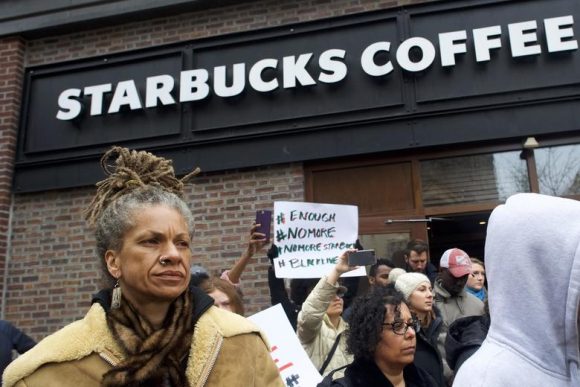Following the arrest of two black men at a Philadelphia Starbucks, Jamelle Bouie wrote this article titled ‘White Spaces’ for Slate.com, where it first appeared. The Pulse does not claim any rights to this article.
By: Jamelle Bouie for Slate.com
Philadelphia is a city in which 43 percent of residents are black. The Philadelphia Starbucks where two black men were arrested last Thursday, however, is located in a zip code that is 79 percent white and just 6 percent black. In all likelihood, most of the clientele there is white, which, to borrow from sociologist Elijah Anderson, makes this particular location a “white space,” or an area whose “most visible and distinctive feature is [the] overwhelming presence of white people and [the] absence of black people.”
This may explain why a Starbucks staff member called the police while the two men were waiting on a business associate. The employee says the men were trespassing and refused to leave the restaurant. Video of the incident—taken by a bystander—shows them standing like any potential customers. That same footage shows their business associate arrive as they are arrested. He is white.
Race is about power and hierarchy. When one is “raced,” one is placed in relationship to that hierarchy—your position assigned to your body and made visible to the world. Places, too, can be raced. Spaces of affluence and exclusivity are typically associated with white faces, reflecting racial distributions of wealth and power. Films like Get Out take that association as a given, a conceit the filmmaker doesn’t even have to explain to the audience. There are “black spaces,” too. In a paper titled “The Iconic Ghetto,” Anderson details the tight association between public housing projects and the black poor, a connection so strong that it’s become part of the overall racial stigma against blacks—a singular black pathology that supposedly explains the material conditions of those projects. Blacks, in this view, come from the ghetto and they carry the ghetto with them, representing its putative danger, crime, and poverty.
To many white Americans, this marks blacks as an inherent threat to the order and safety of their spaces. As Anderson writes, “When the anonymous black person enters the white space, others there immediately try to make sense of him or her—to figure out ‘who that is,’ or to gain a sense of the nature of the person’s business and whether they need to be concerned.”
In these situations, black Americans face heightened scrutiny. This might mean racial profiling, as when shoppers are followed and questioned in retail stores. In 2013, according to the Pew Research Center, 44 percent of black Americans reported such treatment. It might mean unjustified contact with law enforcement. In Pulled Over: How Police Stops Define Race and Citizenship, authors Charles Epp, Steven Maynard-Moody, and Donald Haider-Markel find that suburban and exurban police are much more likely to stop black drivers for intrusive stops; white drivers are rarely stopped for such purposes.
Or it may mean violence. In mid-century Detroit, white mobs attacked and occasionally torched the homes of black people who moved in—or even near—all-white enclaves. In 1986, 23-year-old Michael Griffith died while fleeing a group of white men wielding baseball bats. His offense? Walking through Howard Beach, a largely white neighborhood of Queens, New York. And just last week, 14-year-old Brennan Walker was shot at after knocking on a door in the predominantly white Rochester Hills, Michigan. He was walking to school and had stopped to ask for directions.
The commissioner isn’t wrong about the scope of police authority in this situation. Once called to Starbucks, officers had every right to make an arrest and remove the men from the property. They were released from custody, and company CEO Kevin Johnson issued an apology. The police are conducting an internal investigation of the arrests. What’s critical is that this isn’t an isolated occurrence. Black Americans across class, gender, and other social lines have similar stories of hostile examination, or worse, when they find themselves in a “white space.”
Everyone, eventually, finds themselves out of place. But it’s only some people—raced people—who have to move with particular care through unfamiliar spaces, lest they bring ruinous scrutiny on themselves. And too often, even that caution is not enough.

